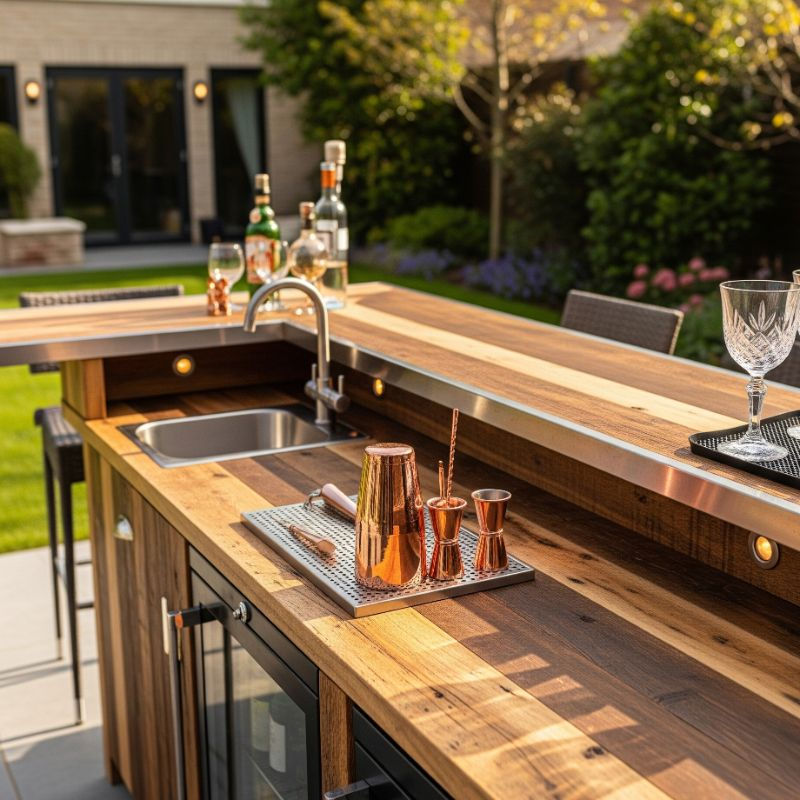Portable Bar for Outdoor Events: Layouts That Speed Service and Cut Foam
- Kaida Rune

- Sep 23
- 3 min read
Explore portable bar layouts that keep outdoor events running smoothly, speed up service, and reduce foam for a better guest experience.

A good outdoor bar feels effortless. Guests order, chat for a minute, and walk away with a crisp pint that tastes like it came off the brewery’s own taps. That doesn’t happen by accident. It’s the result of a smart layout that keeps staff moving in short, repeatable paths—and a draft setup that protects cold, pressure, and cleanliness from keg to glass.
Map the Flow: Order Here, Pour There, Pick Up Once
Start by separating money from beer. Put your POS on one face of the bar and the taps on another, with a clear pickup edge between them. That split turns your team into a small assembly line: one person takes orders and glassware, one pours, one hands off. You’ll cut cross-traffic, shorten each move, and keep the tap handles free from payment bottlenecks.
Keep stations tight. A bartender should be able to reach faucets, rinsers, and glassware without a step. If you’re using a secondary cocktail station, don’t wedge it into the draft lane; park it just outside so your beer pourer isn’t dodging shakers and syrups during the rush.
Keep It Cold All the Way to the Faucet
Foam is usually temperature getting away from you. Pre-chill kegs to the mid-30s before arrival, keep them shaded, and avoid opening the cold compartment more than you have to. If you’re dealing with longer runs, chilled trunk lines or glycol-wrapped shanks keep those last inches cold so carbonation stays in solution and pours stay tight. For a deeper dive on line routing, regulators, and faucet cooling, this guide to setting up a beer tap trailer walks through the decisions that matter outdoors.
Glass temperature counts, too. Warm glassware steals chill and scrubs bubbles out of the beer. A quick blast from a rinser knocks out detergent residue and cools the surface, so the first ounce doesn’t flash foam as it hits the sidewall. You’ll see a steadier head and fewer refills for “short pours.”
Balance Pressure and Distance Like You Mean It
Your layout dictates your gas plan. If taps sit within arm’s reach of the kegs, standard CO₂ at service pressure is usually fine. Push the faucets a few yards away and friction increases; you may need slightly higher pressure or a blend to move beer without over-carbing it in the keg. Keep the regulator for each line where staff can see and adjust it—ideally labeled by style—so you’re not guessing during the dinner rush.
Right-size the beer line, too. Too narrow and you create excess resistance that encourages foam; too wide and you’ll pour fast but lose control of head. Think of line length and inner diameter as a pair—tune them together so your pour lands in six to eight seconds with a clean one-inch cap.
Prep and Hygiene That Pay Off When It’s Busy
Before the first customer shows up, pull test pours until flow, temperature, and head look right. Purge each line, then taste. If a pint seems fizzy, check pressure and confirm the keg is truly cold—not just the air around it. If it tastes dull, confirm the system’s been cleaned recently and the faucets are forward-sealing and tight.
During service, act like you only get one chance to keep things cold. Doors stay closed, kegs aren’t jostled, and faucet tips get wiped between lulls. At breakdown, flush and stage lines for cleaning so you’re not starting the next event behind.
One Clear Takeaway
Fast outdoor bars are designed, not lucky: split the workflow, keep the entire draft path cold, balance pressure for your distance, and protect cleanliness. Do that, and you’ll pour faster with less foam—and your guests will actually taste the beer they came for.



Comments